
Catalog excerpts

SACRAL RODS emergency team for broken bones®
Open the catalog to page 1
• aterial: TiAL6V4 ELI M • asier removal of implant after fracture has healed E • mproved fatigue strength of implant I • educed risk of cold bonding R • educed risk of inflammation and allergy R • Threaded rods with washers and locknuts for ilio-iliac compression osteosynthesis • Stepped thread to increase fatigue strength • Washer: wedge-shaped, ribbed, anatomically contoured • Stable guiding instrument for simple and safe positioning of threaded rods • Socket spanner system with AO standard adapter for fast and simple fastening of nuts SACRAL RODS emergency team for broken bones®...
Open the catalog to page 2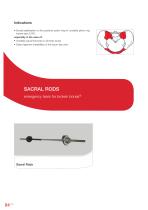
Indications • Dorsal stabilisation on the posterior pelvic ring for unstable pelvic ring injures type C/AO, especially in the case of: • Unstable sacral fractures in all three zones • Osteo-ligament instabilities of the sacro-iliac joint SACRAL RODS emergency team for broken bones® Sacral Rods
Open the catalog to page 4
Sacral Rods The operative management of pelvic ring disruptions has always represented a challenge to the treating surgeon. The sufficient stabilisation of such an injury requires both a profound knowledge of the anatomy and biomechanics of the pelvis and an understanding of the mechanism of fracture. The chosen technique of a posterior stabilisation depends on the one hand on the kind of fracture, and on the other hand on the personal experience of the individual operator. Threaded rods as fixators of posterior pelvic ring instability have been well known and well proven for a long time,...
Open the catalog to page 5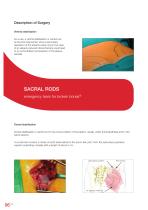
Description of Surgery Ventral stabilisation As a rule, a ventral stabilisation is carried out as the first intervention since a secondary reposition of the anterior pelvic ring in the case of an already reduced dorsal fracture could lead to an uncontrolled compression of the plexus sacralis. SACRAL RODS emergency team for broken bones® Dorsal stabilisation Dorsal stabilisation is carried out in the prone position of the patient, usually under full anaesthesia and in the same session. A curved skin incision is made on both sides lateral to the sacro-iliac joint, from the spina iliaca...
Open the catalog to page 6
Preparation Spina iliaca post. superior Preparation of the subcutaneous fat tissue and carried down to the fascia of the glutaeus maximus muscle. Loosen the musculature from the outer surface of the dorsal os ileum. Linea glutea posterior Reposition A possibly necessary reposition of half of the pelvis is carried out by means of a Schanz screw attached to the crista iliaca. Deployment of the guiding instrument and checking by means of image converter. Guiding instrument: It is strongly advised not to use the enclosed guiding device for reducing bone fragments since it could be damaged in...
Open the catalog to page 7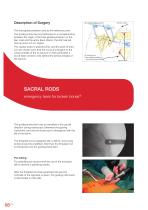
Spina iliaca post. superior The linea glutea posterior acts as the reference point. The guiding instrument is positioned on a considered line between the origin of the linea glutaea posterior on the iliac crest and the spina iliaca inferior; the drill hole will then lie some 0.5 cm higher. The caudal screw is attached first, and the point of entry is to be chosen such that the rod is at a tangent to the crista centralis of the os sacrum or even perforates it, but at least comes to rest behind the lamina dorsalis of the sacrum. connecting line Linea glutea posterior – spina iliaca post....
Open the catalog to page 8
The asymmetric washer, nut and locknut are attached (this is done the most simply by continuing to turn the rod with the drill). Both nuts must be definitively tightened. The drill chuck is released, the guiding instrument removed, and the washer is attached as are, successively, both nuts on the second side using the special socket spanner and the soft-part protector. Wedge shaped spacers: Please note the exact anatomical position shown here to arrive at the best result. SACRAL RODS
Open the catalog to page 9
SACRAL RODS emergency team for broken bones®
Open the catalog to page 10
socket spanner with soft-part protection The first nut is tightened until the desired compression of the fracture area is reached (care must be taken not to use excessive compression with transforaminal fractures of the sacrum.) Both nuts must be tightened. Remove the excess end using the bolt cutters. The same procedure is undertaken with the second screw, which is to be positioned some 2 cm cranially to the first screw. adapter for socket spanner Check Final check using image converter or X-ray, redon drainage, subsequent closure of the wound. SACRAL RODS Postoperative Treatment Dependent...
Open the catalog to page 11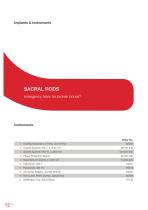
Implants & Instruments SACRAL RODS emergency team for broken bones® Order No. 5 Guiding Instrument, 5 Parts, Sacral Rod 8 Tissue Protection Sleeve 12 AO Screw Adaptor, Socket Wrench 13 Bolt Cutter, Pelvis Screws, Sacral Rod 14 Sterilization Tray, Sacral Rods
Open the catalog to page 12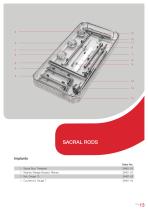
SACRAL RODS Implants Order No. 1 Sacral Rod, Threaded 2 Washer, Wedge-Shaped, Ribbed
Open the catalog to page 13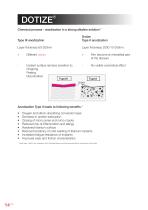
Chemical process - anodization in a strong alkaline solution * Type III anodization Dotize Type II anodization Different colors Film become an interstitial part of the titanium Implant surface remains sensitive to: Chipping Peeling Discoloration No visible cosmetical effect Anodization Type II leads to following benefits * • • • • • • • • Oxygen and silicon absorbing conversion layer Decrease in protein adsorption Closing of micro pores and micro cracks Reduced risk of inflammation and allergy Hardened titanium surface Reduced tendency of cold welding of titanium implants Increased fatigue...
Open the catalog to page 14
Sterilization Guidelines The following remarks should serve as a guideline in the sterilization of medical products. IMPORTANT INDICATIONS FOR DOCTORS AND OPERATING THEATRE PERSONNEL This instruction leaflet refers to all supplied nonsterile implants and all reusable instruments from I.T.S. GmbH. Detailed information for the identification of the product (such as system classification, cat. no.) can be found in the product identification code and/ or on the package label. Make sure that you are familiar with the possibilities of application, combinability and correct handling of the...
Open the catalog to page 16All I.T.S. catalogs and technical brochures
-
ufs
1 Pages
-
DHL
2 Pages
-
ITS
2 Pages
-
PHL
24 Pages
-
ACLS
20 Pages
-
CFN
32 Pages
-
OLS
24 Pages
-
PHLs
20 Pages
-
CTN - Cannulated Tibia Nail
28 Pages
-
SR Sacral Rods
20 Pages
-
HCS
24 Pages
-
TOS Twist-Off Screw
20 Pages
-
TLS
20 Pages
-
PRS-RX
32 Pages
-
HLS
20 Pages
-
ES
20 Pages
-
SR
20 Pages
-
FL
24 Pages
-
PL - Pilon Locking Plate small
12 Pages
-
OL - Olecranon Locking Plate
24 Pages
-
CAS
40 Pages
-
FCN
20 Pages
-
HOL
24 Pages
-
FLS
24 Pages
-
PFL
20 Pages
-
DTL
24 Pages
-
HTO
24 Pages
-
PTL
32 Pages
-
DFL
32 Pages
-
SCL
32 Pages
-
SLS
24 Pages
-
CAL
20 Pages
-
DUL
24 Pages
-
CLS
28 Pages



























































